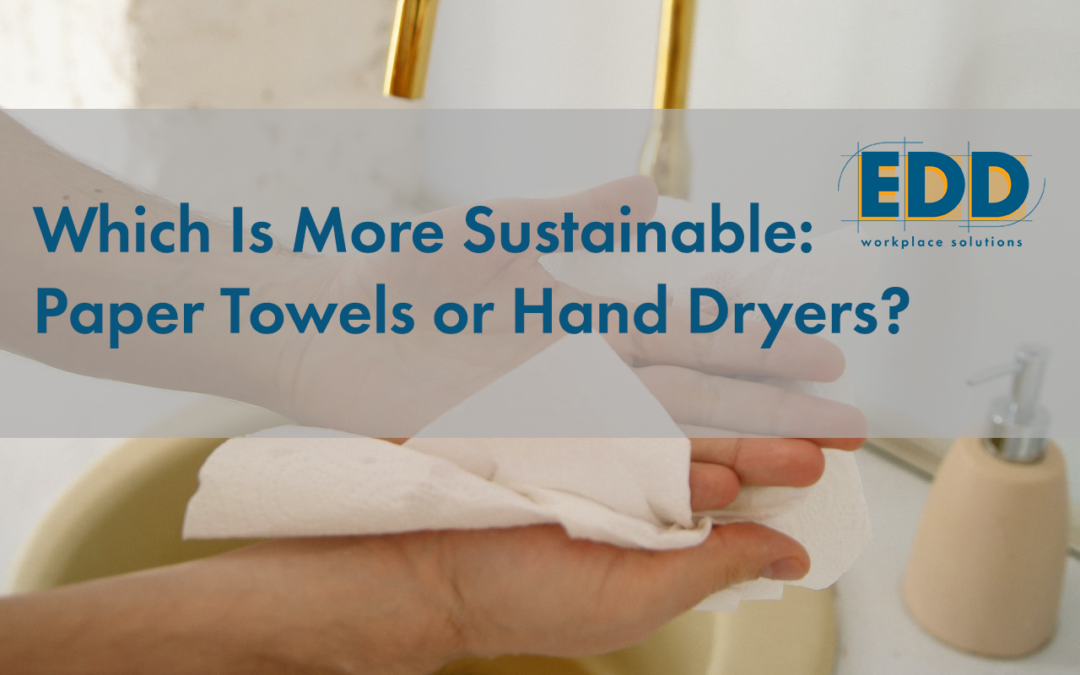At EDD, we believe that selecting a proper hand drying option that creates less environmental impact is an essential responsible practice for both the building owner and designer. In this blog post, we’ll explore how a hand dryer is the preferred sustainable option.
Why are paper towel dispensers the less favorable choice? To calculate the environmental impact of paper towels, one must look at its full life cycle: starting from how the trees are harvested and transported, the amount of chemicals involved in the manufacturing process, to how the waste is managed and disposed. Each process creates a considerable number of harmful pollutants that can be emitted into the environment. Comparatively, hand dryers last a long time and are only replaced about every 10 years.
According to the Office of Business and Economic Development at Sarasota County, Florida, to make one ton of paper towels, 17 trees need to be cut down and 20,000 gallons of water get polluted in the process. An average person uses 2,400 to 3,000 paper towels at work per year and there are over 3,000 tons of paper towel waste produced per day in the U.S. alone.
Aside from the environmental setbacks of using paper towels, there are also other cons to the consumer from using paper towel dispensers. Restroom users can be messy when disposing used paper towels. Paper towels are often left on the ground and around trash cans, increasing maintenance work and requiring more cleaning chemicals, which also means more plastic bottles disposed in the landfill.
There are many different hand dryers available in the market. Most of them are warm-air hand dryers that take up to 20+ seconds and 2400 watts of power to thoroughly dry hands through evaporation. Additionally, conventional warm-air hand dryers take unfiltered restroom air, warm it, and blow it right back into the user’s hands. Rubbing hands together under the warm air dryer risks spreading more bacteria around and defeats the purpose of washing hands.
To reduce energy consumption and select a hand dryer that is hygienic, one of EDD’s recommendations is Dyson’s Air Knife technology hand dryers. It uses a HEPA filter that captures 99.97% of particles, including bacteria and viruses. Speed-wise, wet hands can be dried in as little as 10-14 seconds since the technology literally blows the water off hands with concentrated, unheated air. It costs $19/year to operate the Dyson Airblade model in Eco mode, as it only consumes 650W of power, while paper towels can cost as much as $2,190 annually.
The bottom line is that using high-speed, cool-air hand dryers is the more sustainable choice than paper towel dispensers. Our seemingly small daily behaviors add up and affect the environment for better or worse. We, as designers, can contribute to sustainability by advocating our clients to select efficient and Earth-friendly hand drying solutions for their restrooms. EDD can help your company take the next steps to become more sustainable in the workplace. Let’s do this…one building at a time.
Suggested Content For You
EDD Is Now on the GSA Schedule
We are proud to announce that Eighth Day Design (EDD) is now listed on the GSA Schedule! We have been heavily involved in several government...
Change Management and Returning to a Better Work Experience
The global pandemic has accelerated the transformation of work at an incredible pace. Hybrid work is the new normal and now a preferred...
Better Office Spaces and How To Design Them
| What Makes A Better Office Space? And How Do We Design Them? | The onset of COVID-19 pandemic and the subsequent rise in people working from home...



